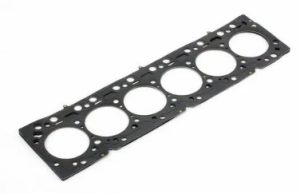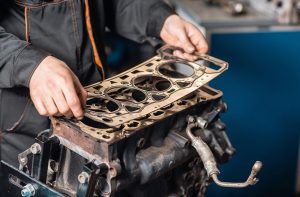A head gasket plays a vital role in the operation of your car’s engine. It seals the combustion chambers, oil passages, and coolant channels between the engine block and cylinder head. When this component fails, it can lead to serious engine damage, expensive repairs, and even complete engine failure if not addressed promptly.
In this article, we’ll explore the most common signs of a blown or failing head gasket, the consequences of ignoring the problem, and the steps you should take next. We’ll also include tables and checklists to help you diagnose the issue and link to where you can find reliable replacement parts.
What Is a Head Gasket and What Does It Do?

A head gasket sits between the engine block and cylinder head, maintaining separation between:
-
Combustion gases
-
Coolant
-
Engine oil
It ensures these three systems don’t mix and helps maintain the correct compression within the combustion chamber.
Common Signs of a Failing Head Gasket
| Symptom | What It Means | Severity |
|---|---|---|
| White smoke from the exhaust | Coolant is entering the combustion chamber | High |
| Milky oil (oil + coolant mix) | Coolant is leaking into the oil passages | High |
| Overheating engine | Coolant is leaking or not circulating properly | High |
| Bubbles in radiator/coolant tank | Exhaust gases entering the cooling system | Medium to High |
| Loss of coolant with no visible leak | Internal coolant leak due to gasket failure | Medium |
| Poor engine performance | Compression loss in one or more cylinders | Medium |
| Check engine light | Engine misfires or sensor alerts due to inefficiencies | Medium |
Visual and Physical Signs of a Blown Head Gasket
1. White Exhaust Smoke
-
Indicates coolant burning inside the combustion chamber.
-
Often smells sweet due to ethylene glycol in coolant.
2. Engine Oil Looks Milky
-
Oil appears light brown or frothy on the dipstick.
-
Caused by coolant mixing with oil — reduces lubrication and can destroy engine bearings.
3. Engine Overheating
-
Temperature gauge spikes unexpectedly.
-
Can lead to warped cylinder heads if not addressed quickly.
4. Bubbling in Coolant Reservoir
-
While the engine is running, bubbles rise through the coolant tank.
-
Caused by exhaust gases leaking into the cooling system.
5. Loss of Compression
-
Engine may idle roughly or lose power.
-
Compression test will show pressure loss in affected cylinders.
How to Confirm Head Gasket Failure
Use the following methods to diagnose the issue:
| Test | Tool Needed | What It Reveals |
|---|---|---|
| Compression Test | Compression gauge | Measures pressure in cylinders |
| Leak-Down Test | Leak-down tester | Identifies where pressure escapes in the engine |
| Chemical Block Test | Combustion leak detector | Detects exhaust gases in the coolant |
| Oil Inspection | Dipstick or oil cap | Reveals coolant in the oil |
| Coolant Pressure Test | Pressure tester | Checks for leaks in the cooling system |
What to Do Next: Step-by-Step Guide
If you suspect your head gasket is failing, here’s what to do:
Step 1: Stop Driving the Vehicle
-
Continuing to drive can warp the cylinder head or damage pistons.
Step 2: Perform a Diagnosis
-
Use the tests listed above.
-
Confirm with a mechanic if unsure.
Step 3: Estimate Repair Costs
| Repair Type | Estimated Cost Range |
|---|---|
| Head gasket replacement (labor + parts) | $700 – $2,000+ |
| Engine rebuild (if severe damage) | $2,000 – $4,000+ |
Note: Early detection can prevent a full rebuild.
Step 4: Buy the Right Replacement Parts
-
Always opt for OEM-quality or better head gaskets.
-
Look for gasket kits that include valve cover gaskets, intake/exhaust gaskets, and seals.
Explore reliable options for buying engine gaskets online.
Step 5: Plan for Installation
-
Replacing a head gasket is complex — best left to professionals unless you have engine-repair experience.
-
A full repair involves:
-
Removing the cylinder head
-
Inspecting for cracks or warping
-
Cleaning all mating surfaces
-
Reinstalling with new gaskets and torqueing bolts to spec
-
What Happens If You Ignore It?
| Ignored Symptom | Potential Result |
|---|---|
| Overheating | Warped or cracked cylinder head |
| Coolant in oil | Damaged engine bearings |
| Low compression | Poor performance, engine misfire |
| Exhaust in coolant | Cooling system damage |
| Delay in repair | Complete engine failure, expensive rebuild |
Preventing Future Head Gasket Failures
-
Maintain correct coolant levels.
-
Change coolant at recommended intervals.
-
Use the right type of coolant for your engine.
-
Replace overheating components (fans, thermostat) proactively.
-
Avoid aggressive driving with an overheated engine.
Summary: Know the Signs, Take Action Early
| Sign | Action |
|---|---|
| White smoke from exhaust | Stop driving, test for failure |
| Overheating | Inspect coolant system & gasket |
| Milky oil | Change oil, confirm gasket issue |
| Bubbling coolant | Check for combustion leak |
Where to Find Quality Head Gaskets

If you’re repairing a head gasket, using high-quality parts is crucial for your engine’s long-term reliability and performance. Make sure to choose OEM-grade gaskets and complete kits that ensure a proper seal and lasting results.
Start buying engine gaskets online — explore a wide selection of gasket kits with fast delivery and compatibility for most car models.
Final Thoughts
A failing head gasket is serious, but early detection can prevent catastrophic engine damage. If you notice any warning signs — from white exhaust to overheating — act quickly. Use proper diagnostics, don’t delay repairs, and always use high-quality replacement parts. Your engine (and your wallet) will thank you.